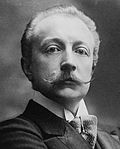Top Qs
Timeline
Chat
Perspective
Ascot tie
Neckband with wide pointed wings From Wikipedia, the free encyclopedia
Remove ads
An ascot tie or ascot is an article of neckwear with wide pointed wings at the end, wrapped around the neck and draped down the chest to cover the front placket and button line of a dress shirt. Formal ascots are always worn above a winged shirt collar and tied at the front, while informal cravats are worn underneath the shirt collar, and are untied. Ascots are traditionally made of patterned silk. While earlier cravats were only found in certain colors due to the difficulty of obtaining and manufacturing pigments and dyes, today's ascot can be found in nearly any color, but is usually seen in neutral tones to match with the dress shirt and suit jacket or tuxedo it might be paired with. This wider relative of the necktie is usually patterned, folded over, and fastened with a tie pin or tie clip. It is usually reserved for formal wear with morning dress for daytime weddings and worn with a cutaway morning coat and striped grey formal trousers.

Remove ads
Derivations
"Modern cravat or "Day Cravat"
- A more casual dress form of ascot is called a modern cravat, or sometimes referred to as a day cravat to distinguish it from the formal ascot. The casual form is made from a thinner woven silk that is more comfortable when worn against the skin, often with ornate and colourful printed patterns. This cravat is tucked underneath the shirt collar, with the front button or front two buttons of the dress shirt undone. It is often difficult for others to distinguish the modern cravat from a scarf or a neckerchief, and therefore the day cravat is reserved for casual occasions, and is rarely seen at formal society functions.
Remove ads
History

The ascot is descended from the earlier type of cravat widespread in the early 19th century, most notably during the age of Beau Brummell, made of heavily starched linen and elaborately tied around the neck. Later in the 1880s, amongst the upper-middle-class in Europe men began to wear a more loosely tied version for formal daytime events with daytime full dress in frock coats or with morning coats. It remains a feature of morning dress for weddings today. The Royal Ascot race meeting at the Ascot Racecourse gave the ascot its name, although such dress cravats were no longer worn with morning dress at the Royal Ascot races by the Edwardian era. The ascot was still commonly worn for business with morning dress in the late 19th and very early 20th centuries.
Remove ads
Civilian use
- Ascot cravat and pin (1904)
- Boni de Castellane, unknown date
- George Augustus Sala, British journalist; after 1863
- John Singer Sargent in a pleated Ascot tie c. 1880
Military use
Summarize
Perspective
Students at the United States Army Officer Candidate School wear ascots as part of their uniform, black for basic officer candidates, blue for intermediate candidates, and white for senior officer candidates.[1] Pararescue trainees (upon completion of extended training day) are given a blue ascot.
In the United States Navy the ascot is now worn for ceremonial purposes with Enlisted Full Dress Whites and Enlisted Full Dress Blue in the Ceremonial Guard.[2]
In the Dutch Army, it is a part of the uniform, for barrack use, the ascot is often in the weapon colors, and with a logo, and when in combat uniform, a DPM or desert version is used.[3]
Likewise the Royal Danish Army employs an ascot for the ceremonial version of the barrack dress, its colors vary between each company.[4]
Military use
- Blue ascot of US Navy Enlisted Full Dress Whites
- White ascot of US Navy Enlisted Full Dress Blues
- Robert Duvall's "Lt Col Kilgore" tropical combat coat and signature yellow ascot from "Apocalypse Now"
- Cyprus National Guard soldier, wearing a blue ascot
- Soldiers of the Polish Army 7th Coastal Defense Brigade, wearing blue ascots striped with the flag of Poland
- Danish soldier, wearing a red ascot
- Japan Ground Self-Defense Force soldiers, wearing red ascots
- Pakistani infantrymen of the Azad Kashmir Regiment, wearing red ascots
- Sentry from the Indian Border Security Force, wearing a striped ascot
- Sentry from the Turkish Presidential Guard, wearing a green ascot
- President Saddam Hussein of Iraq wearing an olive green ascot as a part of his Iraqi Army field marshal's uniform
Remove ads
In media
- In Scooby-Doo, an American horror comedy cartoon franchise, the character Fred Jones wears a signature orange ascot, sometimes mistaken for a scarf. The look was part of the mod look for teenage and young adult men from the late-1960s era Scooby-Doo originates from,[5] and Fred's anachronistic retention of the ascot in some modern incarnations of the series becomes a source of comedy.[6]
- The Eighth Doctor, played by Paul McGann wore a midnight blue ascot tie on the Doctor Who special The Night of the Doctor.
- Bruce Wayne wears an ascot in various incarnations of Batman media.
Remove ads
See also
References
Further reading
External links
Wikiwand - on
Seamless Wikipedia browsing. On steroids.
Remove ads















